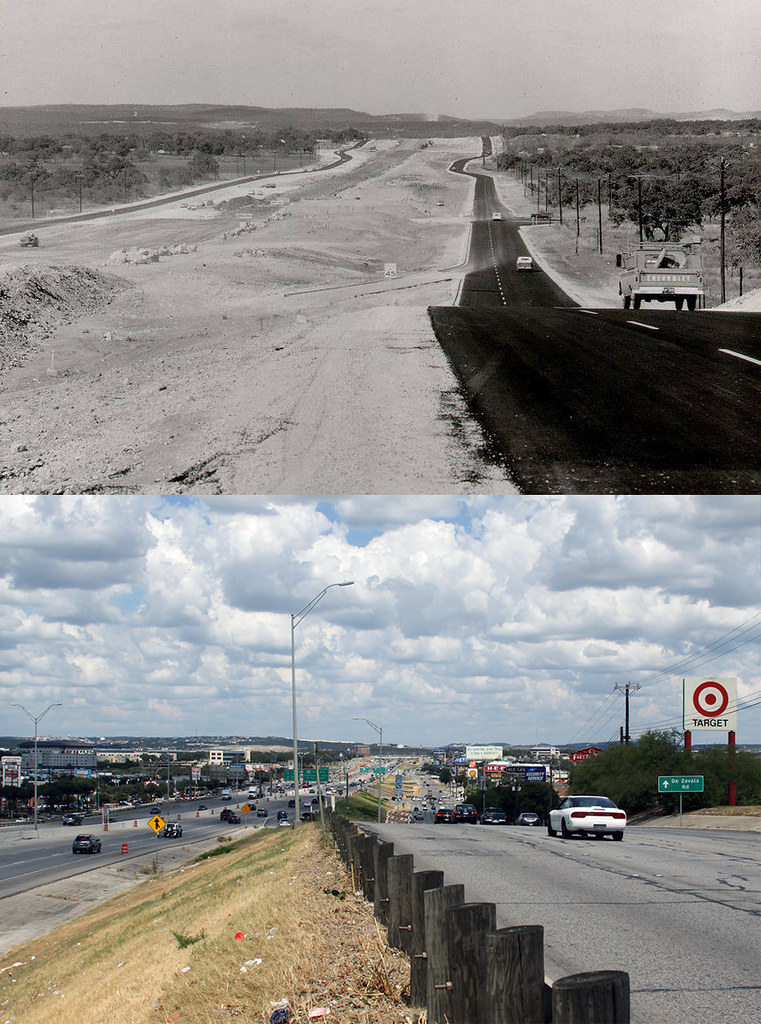
I-10 at DeZavala in 1966

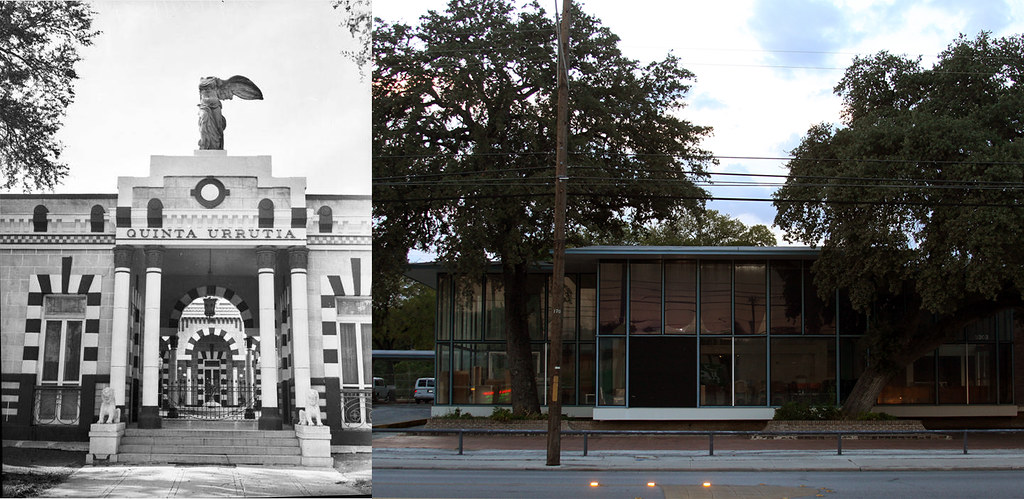
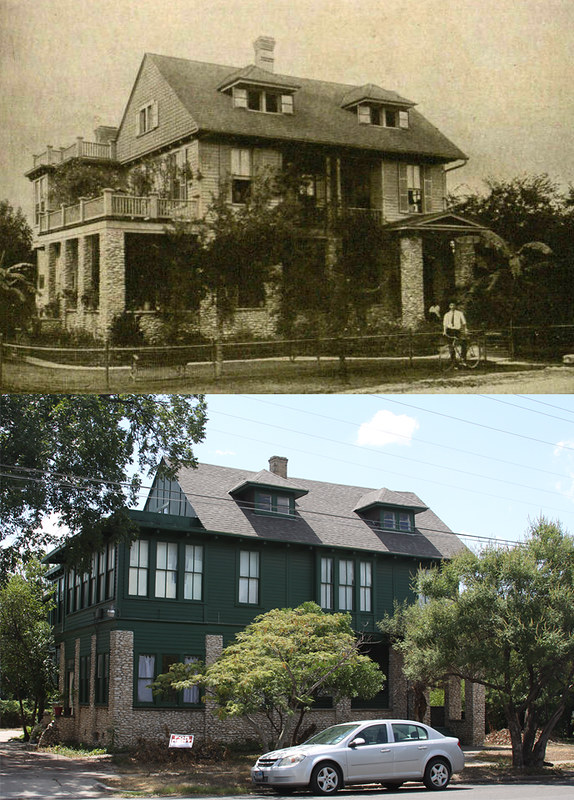
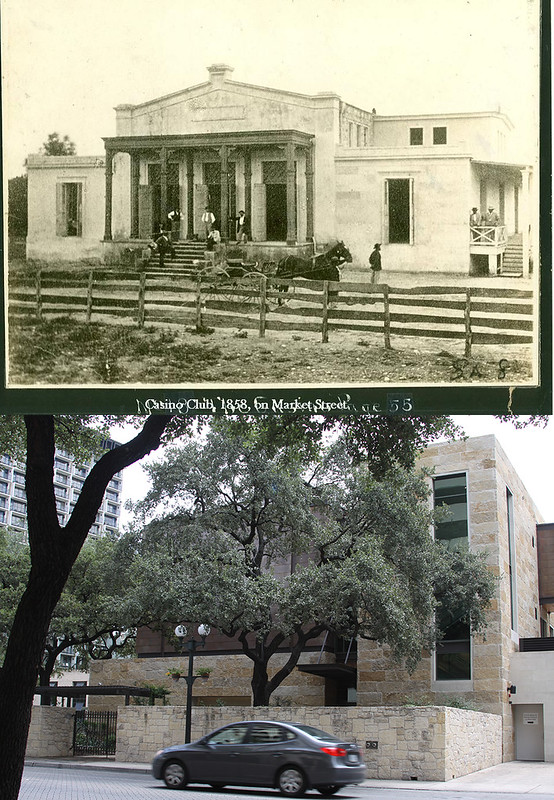
quote:
The Casino Association, San Antonio's first social club, was formed in 1854 and incorporated in 1857. It was formed to promote cultural and literary activities in the city. At the same time, the club was to provide a place of social communication between members. Casino Hall, built on Market Street in 1858, was the city's first theatre. Membership was initially limited to ethnic German men but commissioned U.S. military officers in San Antonio had a standing invitation to be guests at the club. Over time, the membership of the club broadened but the Casino Association was where the elite of San Antonio's German community gathered. Prominent members of the club included Conrad A. Goeth and Albert and Ernst Steves. Much of the club's early business and conversation was conducted in German.
The Casino Association held regular events and special functions in Casino Hall for members and their families. The San Antonio Light called the New Year's Eve Ball at Casino Hall the "most exclusive social function in San Antonio". The club hosted some distinguished guests and performers including Robert E. Lee, Ulysses S. Grant, William T. Sherman, and "Buffalo Bill" William Cody. Income was generated from the rental of the theatre to other groups. In addition to the theatre/ballroom, Casino Hall also offered members the use of a bowling alley, gaming tables and a bar.
Beginning in the 1890s, Conrad A. Goeth was an active member of the Casino Association and served as its President for many years. He was also active in hunting clubs, such as the San Antonio Shooting Company and the Blue Wing Club, and followed the activities of other predominantly German groups around San Antonio like the Sons of Herman. When the German naval ship S.M.S. Bremen was in port at Galveston in 1905, Goeth arranged for the officers to visit San Antonio. He was in regular communication with the Imperial German Consul in Galveston during the early 20th century. In 1916, Mr. Goeth served as President of the German-Texan Bazaar Association. This group organized an event to aid war victims in Europe. For his efforts, he received thanks from the German and Austro-Hungarian embassies in Washington. Some of these records in this series are in German while others are in English.
During Prohibition, the Casino Association's membership and income declined. In 1923, the Casino Association sold the original Casino Hall to the San Antonio Water Board and rented quarters at 110 Nueva Street. In 1925, the Casino Association was consolidated with the San Antonio Club, a literary society formed in 1882. Together the clubs formed the San Antonio and Casino Clubs, also known as the San Antonio-Casino Club. A six story building was constructed at Crockett and N. Presa streets to house the club.

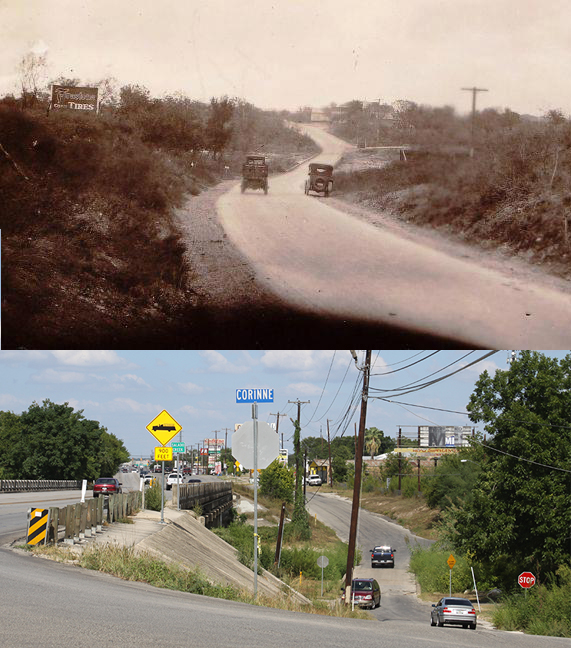









quote:
San Pedro Springs Blockhouse (1906)
In his 1709 diary chronicling an expedition into the northern frontier of New Spain, Franciscan padre Isidro Felix de Espinoza wrote, “Crossing a broad plain, we entered a growth of mesquite with some mottes of live oaks in it. We came upon an irrigation ditch full of water and very well wooded, which was sufficient for a town, and all along it were places to tap the water, for the ditch was on high ground, and the land was sloping. We called it the Waters of San Pedro.”
Not only did Espinoza describe the area where the Villa de San Fernando de Béxar—known to-day as the city of San Antonio—would soon be established, but he also observed an important factor in its founding: the abundant, spring-fed “Waters of San Pedro.”
Archeological evidence found here—including weapons and vessels for carrying water and food—suggest that humans have gathered at these springs for more than 12,000 years.
Nearly a decade after Franciscan missionaries named the springs in 1709, the first San Antonio mission and presidio were established nearby. “These soldiers and their families were the first European settlers in San Antonio,” explains Cardenas. The garrison moved to Military Plaza in 1722, and the mission, San Antonio de Valero, was moved to a site on the San Antonio River in 1724. In time, it included the iconic structure known the world over as the Alamo.
The king of Spain proclaimed San Pedro Springs and surrounding acreage to be an ejido, or public land, in 1729. During the decade of the Republic of Texas, Texas Rangers held horsemanship contests at the springs with Mexican vaqueros and Comanche warriors. Sam Houston addressed a throng at the park in 1860, imploring his fellow Texans not to forsake the Union. Later, as the Civil War raged on, the site held a prisoner of war camp for captured Yankees. After the war, the Union’s newly formed black regiments, the Buffalo Soldiers, camped and trained at the springs before deployment to West Texas.
Markers describe the park’s location on the Camino Real and other historically important features. A camel figure in the children’s playground area recalls the U.S. Army’s experiments using camels in the 1850s as beasts of burden and military transport. Other enigmatic structures evoke San Pedro legends and mysteries. Gregg Eckhardt points out that a small stone building, known as the Block House, is believed by some archeologists to be the oldest Spanish Colonial structure in the state; it does seem possible that the building’s vertical gun ports could have been used to fight off would-be attackers.
Springwater still cascades down a tall, moss-and-fern-covered, cone-shaped grotto. But the flow of the park’s 10 or more springs began decreasing due to drought and pumping from the Edwards Aquifer as early as the 1890s. In the 1940s, the pool closed for a decade, then reopened as a smaller pool filled with city water. Heavy rains and conservation brought the spring flow back, in-ter-mittently, in the early 1990s. Today, when conditions are favorable, springwater fills several smaller, emerald-green ponds before continuing on to San Pedro Creek.
www.texashighways.com/index.php/component/content/article...
This particular blockhouse is rumored to be one of the oldest structures in town, but I don't know if I buy that. For now, the exact reason why this stone building was built is still unknown.

quote:
Peacock Military Academy in 1894
Now the property of The Salvation Army, the historic Wesley Peacock House (built
in 1890) is the official home of the Women's Auxiliary of The Salvation Army as
well s the records office of the Alumni Association of the former Peacock
Military Academy. It is also a museum of Antiques, artifacts, photographs, and
memorabilia from the Peacock family and the Peacock Military Academy.
Professor Wesley Peacock, Sr. founded the Peacock School for Boys in 1894. When
military training was added in 1900 the name of the school was changed to
Peacock Military Academy. The Wesley Peacock House was the administration
headquarters and hospitality center for the school. The professor and his
family lived in the upstairs rooms of the house.
In those early years of the school, the house was Victorian in style with two
stories and ten rooms with fireplaces in all but one room. The first floor
consisted of a reception room, a parlor/music room, library, dining room and
kitchen. Outside the kitchen was an enclosed patio porch for taking meals. Two
staircases let to the second floor containing four bedrooms and one bathroom.
The front three rooms on the first floor were used as classrooms. In addition
to the house, there was a carriage house with quarters for servants and an
adjoining building which Professor Peacock used as his office. There was also a
barn and stalls for horses.
A fire in 1931 on the second floor of the house prompted major remodeling. Gone
forever were the lovely porches and gingerbread trim of Victorian times. With
the addition of a conference room in 1960, the house took the final step toward
its metamorphosis into becoming a strictly utilitarian building -- the Academy
Headquarters.
When the school closed in 1973, the Peacock family deeded the house, along with
eighteen school buildings and the twenty-acre campus to The Salvation Army. In
1979 the Texas Historical Commission place a bronze plaque on the front of the
building, naming it a historical site. In addition, The Salvation Army's state
commander designated it the official home of the Women's Auxiliary and records
office of the Peacock Alumni Association. The house then officially became the
repository of academy records, archives and memorabilia -- a mini-museum.


quote:
Seay Common School in 1951. (Jung Rd)
Ms. Wietzel, teacher of the Seay Common School, began her day very early. She had to drive over several roads from Sommerset to Wetmore to her little one room schoolhouse just off of Jung Road near the railroad tracks.
Her car had wide running boards on either side, and as she made their way to the school, students would jump on the running boards and hang on for a ride to school. There was no bus service, and the children came by bicycle, horse, and foot.
Once at the school, she would unlock the door and start filling the big iron stove with wood.
The kerosene lantern may have to be lit if it were a cloudy or dark day. No electricity ran through the small community at this time, as well as, no phone service, or indoor plumbing.
A bucket would be lowered into the well outside the little schoolhouse, and a tin cup would be placed beside it for sharing drinks throughout the day.
The children were from families in the area, or migrant workers making their yearly visit to the families to help with the planting or harvesting. Most of the families were of German heritage.
1938 , the original Seay Common School was sold to a family who turned it into a home adding a garage and shed, along with a porch.
The Common Schools became part of the North East Independent School District in 1955


quote:
"Crownover Residence on North Flores St (1941) Now the MKT Restaraunt parking lot. The photo is described as the pre-civil war Crownover Residence but after hours of online research I can't confirm that. The age of the house suggests that either the Baylors, Herffs, Vances or Devines might have owned the property at one point when this part of town along the San Pedro Creek was well outside the city limits. Pasita de Apacheria as it was sometimes called was the road to the German settlements in Comfort and Fredericksburg. Now Flores St, the Crownover Residence has an identical twin built around the same time in Comfort that is still owned by the Crownover family lends credence to the claim of ownership in my opinion.

quote:
Westend Suburb (Woodlawn Lake) Ashby and Peacock
Now the property of The Salvation Army, the historic Wesley Peacock House (built
in 1890) is the official home of the Women's Auxiliary of The Salvation Army as
well s the records office of the Alumni Association of the former Peacock
Military Academy. It is also a museum of Antiques, artifacts, photographs, and
memorabilia from the Peacock family and the Peacock Military Academy.
Professor Wesley Peacock, Sr. founded the Peacock School for Boys in 1894. When
military training was added in 1900 the name of the school was changed to
Peacock Military Academy. The Wesley Peacock House was the administration
headquarters and hospitality center for the school. The professor and his
family lived in the upstairs rooms of the house.
In addition to the house, there was a carriage house with quarters for servants and an
adjoining building which Professor Peacock used as his office. There was also a
barn and stalls for horses.
When the school closed in 1973, the Peacock family deeded the house, along with
eighteen school buildings and the twenty-acre campus to The Salvation Army. In
1979 the Texas Historical Commission place a bronze plaque on the front of the
building, naming it a historical site. In addition, The Salvation Army's state
commander designated it the official home of the Women's Auxiliary and records
office of the Peacock Alumni Association. The house then officially became the
repository of academy records, archives and memorabilia -- a mini-museum.

quote:
Union Stock Yards in 1948. Closed after 112 years of operation in 2001 some of the facilities are being used as warehouses.

quote:
Salado Valley Common School in 1938.
(Wetmore Rd near the airport)
In 1938, Salado Valley would be upgraded into a modern facility for its day, with aid from WPA funds, a $4,000 bond issue and with members of the school board assisting in the construction. Even though considered modern, the school lacked indoor plumbing and a cafeteria.
For lunch, most students provided their own or traveled back home, either by walking or riding bicycles.
These rural students, rich in German and Hispanic heritage, living in the northeast county region on nearby dairy farms, would attend Salado Valley Common School for grades 1-8. After the eighth grade, students completed their education at the nearby Alamo Heights High School.
This rural school, operated through 1955, the old schoolhouse transformed into the first central office for district administrators and continued to do so until 1958 when the building was razed for progress. In its place, a new administrative building was constructed and functioned as central office till 1972.

quote:
St Mary's Hall in 1882
(Navarro and Martin)
Saint Mary's Hall, founded in 1879 by the first Bishop of the Protestant Episcopal Church in the Diocese of West Texas, was a boarding and day school for girls of all faiths.
In 1925 Saint Mary's Hall was incorporated to be administered as a non-profit educational institution with an independent self-perpetuating Board of Trustees. At that time, the school moved to the site on French Place, now the site of San Antonio Academy, where it operated for 43 years.
In 1964, the Board of Trustees, facing the problems of progress and expansion, decided that the school should develop a new campus to meet present needs and future demands for continued excellence in the field of independent education. The current 60-acre campus was designed by famous architect O'Neil Ford in 1968 and occupied in November 1968.


quote:
St John Berchman's in 1903.
(Brady and Zarzamora)
Several Belgians established truck farms on the southwestern outskirts of the town and sold fresh vegetables, fruits, flowers and pecans in the markets.
Herman Van Daele grew up on his family’s truck farm in Liedekerke, Belgium, but at the age of 50, in 1884, he was moved by the spirit of adventure to come to San Antonio. He first acquired land on the old Frio City Road—then a year later, he found rich soil at a good price near the intersection of South Brazos and South Laredo Streets. There he laid out a 20-acre farm, but he had to haul water from Apache Creek or buy water from people along San Pedro Creek. He got together with his neighbor, Adolph Baeten, to drill an artesian well, with Baeten paying for the drilling on Van Daele’s land and the two of them sharing the water. Then with plenty of water, Van Daele was able to start a dairy in addition to his truck farm.
Van Daele’s well, one of the first dug in Bexar County, supplied water not only for irrigation of the two farms, but to sell at a penny per barrel to Tejano water haulers who drove up in their wagons, paid to have their barrels filled, and hauled the water into town for sale.
Van Daele’s partner, Adolph Baeten, also came to San Antonio as an experienced truck farmer when he was almost 30, in 1888. After working odd jobs, he leased land from Van Daele on Probandt Street, south of town, and began his farm. Eventually, in 1907, he moved to a 32-acre site on Zarzamora Street, where the Baeten Truck Farm became a showplace and was noted for introducing new vegetables and fruits to the area.
Other Belgians came in the 1890s and began farming. Charles Persyn wrote to his brothers Pete and Casmire to come to San Antonio, which they did. Pete Persyn became known for his superior radishes and is credited with introducing cauliflower to the San Antonio markets.
Peter Hooge left the family farm in Belgium in 1892 and came to San Antonio. After working on the railroad for two years, he was joined by his brother and they rented 25 acres of land on Probandt Street and began raising vegetables. They sent money home so their father and five brothers and sisters could join them in 1896. While the older family members worked in the fields, Stephanie Hooge took care of her five younger brothers and sisters, taught them basics of education and the catechism. She expanded this work to include other children of the Belgian colony. Her “school” was a one-room building also used by the adults as a chapel for services when the priest from Sacred Heart Parish visited them. The chapel became known as St. John Berchmans, named by Stephanie for a 17th Century Belgian saint. St. John Berchmans was the Belgian national parish until 1947, with all services were conducted in Flemish. The parish moved in 1948, but the old church building was used for meetings of the Belgian-American Club of Texas for years.


quote:
Van de Walle Farm, 1906-1912
Zarzamora St
Several Belgians established truck farms on the southwestern outskirts of the town and sold fresh vegetables, fruits, flowers and pecans in the markets.
Herman Van Daele grew up on his family’s truck farm in Liedekerke, Belgium, but at the age of 50, in 1884, he was moved by the spirit of adventure to come to San Antonio. He first acquired land on the old Frio City Road—then a year later, he found rich soil at a good price near the intersection of South Brazos and South Laredo Streets. There he laid out a 20-acre farm, but he had to haul water from Apache Creek or buy water from people along San Pedro Creek. He got together with his neighbor, Adolph Baeten, to drill an artesian well, with Baeten paying for the drilling on Van Daele’s land and the two of them sharing the water. Then with plenty of water, Van Daele was able to start a dairy in addition to his truck farm.
Van Daele’s well, one of the first dug in Bexar County, supplied water not only for irrigation of the two farms, but to sell at a penny per barrel to Tejano water haulers who drove up in their wagons, paid to have their barrels filled, and hauled the water into town for sale.
Van Daele’s partner, Adolph Baeten, also came to San Antonio as an experienced truck farmer when he was almost 30, in 1888. After working odd jobs, he leased land from Van Daele on Probandt Street, south of town, and began his farm. Eventually, in 1907, he moved to a 32-acre site on Zarzamora Street, where the Baeten Truck Farm became a showplace and was noted for introducing new vegetables and fruits to the area.
Other Belgians came in the 1890s and began farming. Charles Persyn wrote to his brothers Pete and Casmire to come to San Antonio, which they did. Pete Persyn became known for his superior radishes and is credited with introducing cauliflower to the San Antonio markets.
Peter Hooge left the family farm in Belgium in 1892 and came to San Antonio. After working on the railroad for two years, he was joined by his brother and they rented 25 acres of land on Probandt Street and began raising vegetables. They sent money home so their father and five brothers and sisters could join them in 1896. While the older family members worked in the fields, Stephanie Hooge took care of her five younger brothers and sisters, taught them basics of education and the catechism. She expanded this work to include other children of the Belgian colony. Her “school” was a one-room building also used by the adults as a chapel for services when the priest from Sacred Heart Parish visited them. The chapel became known as St. John Berchmans, named by Stephanie for a 17th Century Belgian saint. St. John Berchmans was the Belgian national parish until 1947, with all services were conducted in Flemish. The parish moved in 1948, but the old church building was used for meetings of the Belgian-American Club of Texas for years.

